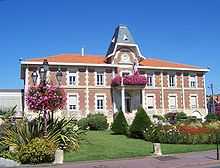Soulac-sur-Mer
| Soulac-sur-Mer | ||
|---|---|---|

|
|
|
| region | Nouvelle-Aquitaine | |
| Department | Gironde | |
| Arrondissement | Lesparre-Médoc | |
| Canton | Le Nord-Médoc | |
| Community association | Médoc Atlantique | |
| Coordinates | 45 ° 31 ′ N , 1 ° 7 ′ W | |
| height | 0-25 m | |
| surface | 28.89 km 2 | |
| Residents | 2,811 (January 1, 2017) | |
| Population density | 97 inhabitants / km 2 | |
| Post Code | 33780 | |
| INSEE code | 33514 | |
| Website | http://www.mairie-soulac.fr/ | |
Soulac-sur-Mer is a French town with 2,811 inhabitants (at January 1, 2017) in the Gironde department in the region Nouvelle-Aquitaine . It is located on the peninsula west of the Gironde estuary, in the Médoc , on the Atlantic coast.
history
It is said that Soulac was built on or near the ruins of the ancient city of Noviomagus mentioned by Ptolemy . However, there is no evidence of this. The city is first mentioned in 1035 as the site of a monastery. From 1103 it was subordinate to the Benedictine Abbey of Sainte-Croix in Bordeaux as a priory .
At that time, the port developed into a starting point for the pilgrimage to Santiago de Compostela , the Way of St. James . Pilgrims from all over Europe went ashore here to tackle the chemin littoral on foot along the Atlantic coast, via Andernos-les-Bains , Bayonne , Hendaye , and via Irun on the Spanish Camino de la Costa . The Church of Notre-Dame-de-la-Fin-des-Terres was built for her first prayer on land. Since 1998 it has been listed as part of the UNESCO World Heritage “Camino de Santiago in France”.
Today the coastal path in France is considered a bypass to the main routes of the Camino de Santiago.
The place gained its importance through a legend according to which Saint Veronica , her husband Zacchaeus and Saint-Martial came to Gaul in the 1st century AD to Christianize it. (See also the story of Rocamadour ). They went ashore in Soulac.
Since the 16th century, the stationing of soldiers superimposed the role of monks and pilgrims. In 1622 Soulac was taken by the Huguenots under Jean de Favas . Regular religious operations in the monastery could not be resumed until 1692. In the next fifty years, however, it would come to a complete standstill, as a sand dune buried the monastery and church.
Soulac also had to be relocated at this time. Since the 19th century it has developed into a popular seaside resort, the northernmost on the Aquitaine coast. Many buildings from the 19th century have been preserved. Despite the low number of residents, thanks to its function as a center for the surrounding tourist resorts, it is a lively city with a variety of shopping and entertainment options during the season.
Population development
| year | 1962 | 1968 | 1975 | 1982 | 1990 | 1999 | 2007 | 2017 |
| Residents | 2113 | 2198 | 2387 | 2536 | 2790 | 2720 | 2679 | 2811 |
| Sources: Cassini and INSEE | ||||||||
Attractions
Notre-Dame-de-la-fin-des-Terres
The pilgrimage church Notre-Dame-de-la-fin-des-Terres is a former Benedictine monastery church from the 12th century.
Field character discovery
In 1989 the remains of a Gaulish standard , a brass wild boar figure , were discovered on a beach near Soulac . On the openwork back crest there are motifs comparable to the Dejbjerg pattern . It is believed that the more than half a meter long standard as it was found, was sacrificed in a cultic act, probably in the late Celtic period. The remains are kept in their original state in the community's Museum of Art and Archeology, a reconstruction copy was made by the Roman-Germanic Central Museum in Mainz . On June 4, 2007, the French Post issued a € 1.30 postage stamp depicting the statue.
Community partnerships
Personalities
- Georges Mandel (1885–1944), French journalist and politician
- Marie Laforêt (1939–2019), French chanson singer and actress
literature
- WHC Nomination Documentation (PDF; 91.1 MB), application documents for nomination as World Heritage, here: Section "Soulac, Eglise Notre-Dame-de-la-Fin-des-Terres"
- Dietrich Ankner: The metal alloy of the late Celtic boar from Soulac-sur-Mer: A special type of bronze corrosion in the ground. In: Archaeological correspondence sheet . Vol. 26, No. 4, 1996, pp. 457-461.
- Le Patrimoine des Communes de la Gironde. Flohic Éditions, Volume 2, Paris 2001, ISBN 2-84234-125-2 , pp. 1427-1431.
Web links
- Mairie Soulac (City Council, French)
- Official tourist information
- Bettina Kaps: France's coastal erosion (1/5) - When the house tips over into the sea. (also as mp3 audio , 6.2 MB, 6:45 minutes) In: Deutschlandfunk broadcast “Europe today”. August 20, 2018. Retrieved August 20, 2018 .





